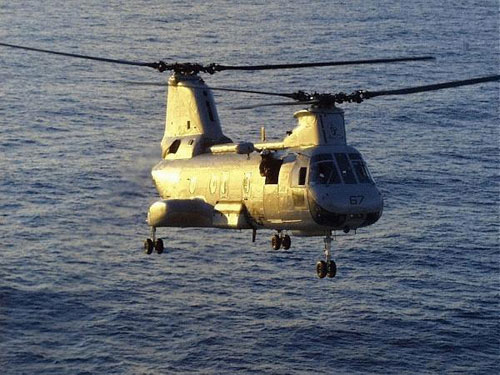CH-46 Sea Knight
Summary
| Category | Military Helicopters |
| Origin country | 🇺🇸 United States |
| Manufacturer | Boeing/Vertol |
| First flight | 22 April 1958 |
| Year introduced | 1964 |
| Number produced | 524 units |
| Average unit price | $14 million |
Description
Development of the Sea Knight, originally designated Vertol Model 107, began in 1956. Conceived as a successor to piston-engine rotorcraft, it utilized the emergent turboshaft engine. The prototype, powered by two Lycoming T53 turboshaft engines, first flew on 22 April 1958. In June 1958, the U.S. Army awarded Vertol a contract for ten production aircraft, designated YHC-1A, reduced later to three. In 1961, the U.S. Marine Corps selected Boeing Vertol's Model 107M as the basis for a medium-lift, twin-turbine cargo/troop assault helicopter. The Sea Knight first flew in August 1962, receiving the military designation CH-46A.
The Boeing Vertol CH-46 Sea Knight is a medium-lift tandem-rotor transport helicopter with counter-rotating main rotors. Power is supplied by two General Electric T58 turboshaft engines mounted on each side of the rear rotor pedestal, with a drive shaft transferring power to the forward rotor. The engine configuration provides redundancy, allowing either engine to power both rotors. Each rotor has three foldable blades. It features a fixed tricycle landing gear with twin wheels. The main landing gear is installed within protruding rear sponsons housing fuel tanks, with a total capacity of 350 US gallons (1,438 L). Its cargo bay includes a rear loading ramp, which can be removed or left open in flight. The aircraft can be outfitted with an internal winch and an optionally-attached belly-mounted cargo hook, rated at 10,000 lb (4,500 kg). The Sea Knight can land directly on water and float for a limited time in calm conditions.
For self-defense, a pintle-mounted 0.50 in (12.7 mm) M2 Browning machine gun could be mounted on each side of the helicopter. A ramp-mounted 7.62 mm (0.30 in) M240D machine gun was optional. When carrying cargo, the CH-46 could accommodate up to 24 troops, 15 stretchers and two attendants, or 7,000 lb (3,200 kg).
The Sea Knight saw extensive operational use across all US Marine operational environments between its introduction during the Vietnam War and its retirement in 2015. CH-46s transported personnel, evacuated wounded, supplied forward arming and refueling points (FARP), performed vertical replenishment, search and rescue, recovered downed aircraft and crews, and performed other tasks. During the Vietnam War, the CH-46 was a primary US Marine troop transport helicopter. Marine CH-46s participated in Operation Frequent Wind, the evacuation of Saigon, in April 1975 and the last helicopter to leave the roof of the US embassy was a CH-46 of HMM-164. By the end of US military operations in Vietnam, over a hundred Sea Knights had been lost to enemy fire. CH-46E Sea Knights were used by the U.S. Marine Corps during the 2003 invasion of Iraq and subsequent operations, frequently in the CASEVAC role, requiring 24/7 availability regardless of conditions. The U.S. Navy retired the type on 24 September 2004, replacing it with the MH-60S Seahawk, while the Marine Corps maintained its fleet as the MV-22 Osprey was fielded. Several overseas operators acquired the rotorcraft; Canada operated the Sea Knight, designated as CH-113, predominantly in the SAR role until 2004. Other export customers included Japan, Sweden, and Saudi Arabia.
Main Variants:
-
Model 107-II: The commercial airline helicopter version, with subsequent commercial aircraft produced as BV 107-II-2 models.
-
Model 107M: The company model number for the military transport version of the BV-107/II-2, designed for the U.S. Marine Corps.
-
YHC-1A: The Vertol Model 107 configured for testing by the United States Army, later adopted by the U.S. Marine Corps as the HRB-1.
-
CH-46A: The medium-lift assault and cargo transport and SAR helicopter for the USMC, fitted with two 1,250 shp (935 kW) General Electric T58-GE-8 turboshaft engines.
-
CH-46E: Approximately 275 -A, -D, and -F airframes updated to CH-46E standards with improved avionics, hydraulics, drive train and upgraded T58-GE-16 and T58-GE-16/A engines.
Technical specifications
| Version: CH-46A | |
|---|---|
| Crew | 3 + 1 mechanic (+ 2 door-gunners in fight mode) |
| Operational range | 296 km (184 mi) |
| Maximum speed | 266 km/h (165 mph) |
| Wingspan | 16 m (52.5 ft) |
| Height | 5.1 m (16.7 ft) |
| Length | 13.9 m (45.7 ft) |
| Service ceiling | 4,267 m (13,999 ft) |
| Empty weight | 7,047 kg (15,536 lbs) |
| Max. takeoff weight | 11,000 kg (24,251 lbs) |
| Climb rate | 10.4 m/s (34.1 ft/s) |
| Powerplant | 2 x turboprops General Electric T58-GE-16 delivering 1400 kW each |
Current operating countries
All operators

